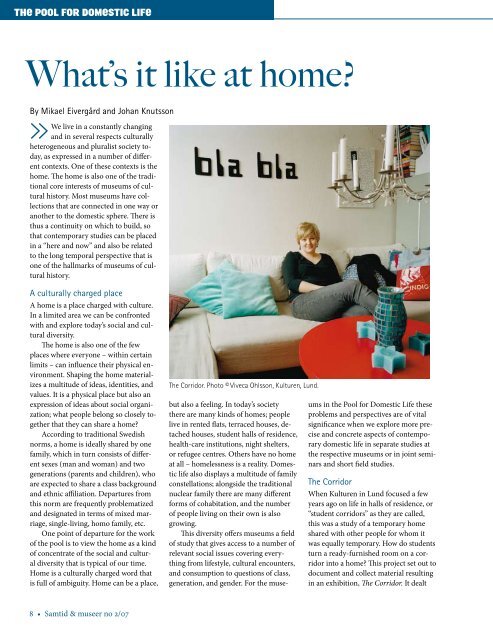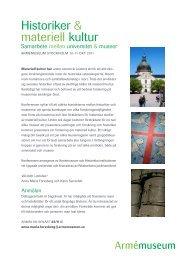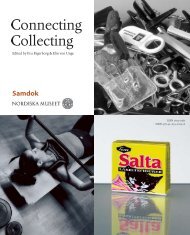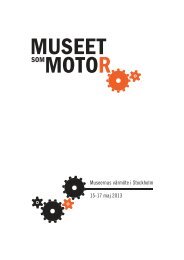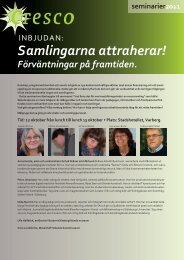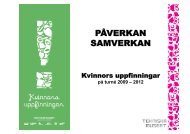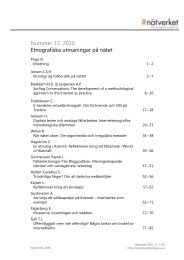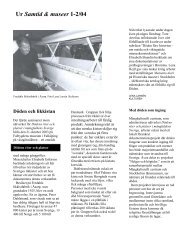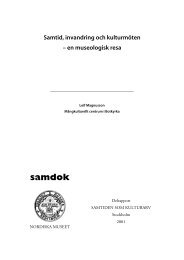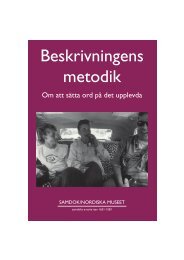The Pool for Domestic LifeWhat’s it like at home?By Mikael Eivergård and Johan Knutsson»We live in a constantly changingand in several respects culturallyheterogeneous and pluralist society today,as expressed in a number of differentcontexts. One of these contexts is thehome. The home is also one of the traditionalcore interests of museums of culturalhistory. Most museums have collectionsthat are connected in one way oranother to the domestic sphere. There isthus a continuity on which to build, sothat contemporary studies can be placedin a “here and now” and also be relatedto the long temporal perspective that isone of the hallmarks of museums of culturalhistory.A culturally charged placeA home is a place charged with culture.In a limited area we can be confrontedwith and explore today’s social and culturaldiversity.The home is also one of the fewplaces where everyone – within certainlimits – can influence their physical environment.Shaping the home materializesa multitude of ideas, identities, andvalues. It is a physical place but also anexpression of ideas about social organization;what people belong so closely togetherthat they can share a home?According to traditional Swedishnorms, a home is ideally shared by onefamily, which in turn consists of differentsexes (man and woman) and twogenerations (parents and children), whoare expected to share a class backgroundand ethnic affiliation. Departures fromthis norm are frequently problematizedand designated in terms of mixed marriage,single-living, homo family, etc.One point of departure for the workof the pool is to view the home as a kindof concentrate of the social and culturaldiversity that is typical of our time.Home is a culturally charged word thatis full of ambiguity. Home can be a place,The Corridor. Photo © Viveca Ohlsson, Kulturen, Lund.but also a feeling. In today’s societythere are many kinds of homes; peoplelive in rented flats, terraced houses, detachedhouses, student halls of residence,health-care institutions, night shelters,or refugee centres. Others have no homeat all – homelessness is a reality. Domesticlife also displays a multitude of familyconstellations; alongside the traditionalnuclear family there are many differentforms of cohabitation, and the numberof people living on their own is alsogrowing.This diversity offers museums a fieldof study that gives access to a number ofrelevant social issues covering everythingfrom lifestyle, cultural encounters,and consumption to questions of class,generation, and gender. For the museumsin the Pool for Domestic Life theseproblems and perspectives are of vitalsignificance when we explore more preciseand concrete aspects of contemporarydomestic life in separate studies atthe respective museums or in joint seminarsand short field studies.The CorridorWhen Kulturen in Lund focused a fewyears ago on life in halls of residence, or“student corridors” as they are called,this was a study of a temporary homeshared with other people for whom itwas equally temporary. How do studentsturn a ready-furnished room on a corridorinto a home? This project set out todocument and collect material resultingin an exhibition, The Corridor. It dealt8 • Samtid & museer no 2/07
The Pool for Domestic LifeWhat kind of life is lived behind the door in the suburbs, in a residential area, or in a smallvillage in the remote forest? And what does it look like inside? The task of the Pool for DomesticLife is to explore and document people’s homes and domestic life in contemporary Sweden fromdifferent perspectives.with the way we create a sense of homein a different environment, the hall ofresidence, examining attitudes to housingand visions of the future. The projectreceived financial support from the studenthousing company AF Bostäder inLund, to mark its 50th anniversary in2004.The participating museums carry outmany projects like The Corridor, basedon the conditions and needs of the individualmuseum, and not infrequentlywith external finance. In these contextsthe Samdok organization plays a crucialpart, as support and as a soundingboard.Consuming a homeA theme that has been in the foregroundfor the work of the pool in recent years isthe home in the post-modern consumersociety. This is an interest we share withthe Pool for Leisure, which is why thetwo pools have had a number of jointmeetings and field seminars. Creatingand choosing, two of the “duties” of theconsumer society, are equally relevantfor questions of domestic life and leisure,and thus served as the point of departurefor two small-scale studies.A year ago it was about IKEA. Altogetherthe field studies in an IKEAstore in Gothenburg gave a multifacetedpicture of what steers people’s purchasesand choices. Trends in interior decorationand lifestyle, people’s views of thehome and its individual design weremixed with insights into shopping as aleisure pursuit.The bathroom as a place for enjoyment,practical functions, and interiordesign aesthetics was the theme of thisspring’s joint effort, with field studies inshops, departments stores, and homes inMalmö and Lund. Bathroom makeoversare the latest trend in interior decoration.Here consumption and do-ityourselfare combined with ideas abouta special place in the home where onecan wind down and prepare to wind upagain. With the bathroom study we alsowanted to illuminate the polarizationbetween the dream images of marketingand the factual circumstances of reality.In the bathroom it is not just a matterof changing the fixtures but perhapsabove all of giving the little space newfunctions. At least in advertising, thebathroom is represented as being simultaneouslya place for display to visitorsand a place to which you can retreat andrelax, to devote some time to yourselfafter an active day. The advertisementsfrequently talk about the bathroom interms of “a spa of your own”, and thereader is confronted with pictures offresh-looking people wrapped in bigwhite towels, chatting on the edge of thebathtub.When regarded in a slightly broaderperspective, the transformation of Swedishbathrooms is about how the newconsumerism contributes to changingthe content and meaning of the home.On the one hand, it is virtually a citizen’sduty today to consume, and possible andobligatory changes of the home are oneof the strongest incentives for the individual’sconsumption. At the same time,and this may seem paradoxical, thismass consumption gives the individualthe possibility to shape the home exactlyas he or she wants it. The home becomesa space for display, where not only aperson’s social position but also, andperhaps especially, personal identity andpreferences are expected to take shape.Refugee centre in Bräcke. Photo Björn Oskarsson©Jämtland County MuseumChangeable homesIt is at the interface between the privatehome and the social and culturalcircumstances that the Pool for DomesticLife has its field of operation. Thehome, and the family, are often perceivedas stable institutions. When theconstruction of the modern welfarestate took shape in the post-war years,the home, with the nuclear family asthe foundation of society, was one ofthe places where the political ambitionshad their most palpable expression.Rationalization was to be achieved here,good habits were to be implemented,and breaches of norms were to be combated.Today the home and the familyare phenomena that can be described asa throng of constellations and variationsof a cultural, social, ethnic, and sexualkind that teach us through their very existencethat what we tend to perceive asthe solidity of existence is in fact characterized,if not by fragility, then at least byconstant change. That is why the homeis also a culture-producing space of thegreatest importance for museums orientedto the present day. pMikael Eivergård was formerly head antiquarianat Jämtland County Museum and chair ofthe Pool for Domestic Life and is now publichealth planning officer at The Swedish NationalInstitute of Public Health,mikael.eivergard@fhi.seJohan Knutsson is curator at the NordiskaMuseet and secretary of the Pool for DomesticLife, johan.knutsson@nordiskamuseet.seSamtid & museer no 2/07 • 9


